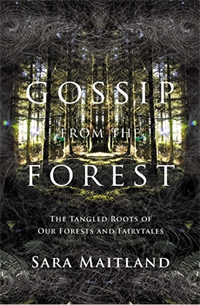 Why do forests capture our imagination? And why are so many fairytales, at least in the Northern European tradition, rooted in forests? Sara Maitland’s Gossip from the Forest is a fascinating and freewheeling exploration of how people shape the natural world, which shapes the tales we tell, which in turn shape us.
Why do forests capture our imagination? And why are so many fairytales, at least in the Northern European tradition, rooted in forests? Sara Maitland’s Gossip from the Forest is a fascinating and freewheeling exploration of how people shape the natural world, which shapes the tales we tell, which in turn shape us.
Maitland opens with the original meaning of the word ‘gossip’ (“one who has contracted a spiritual relationship to another, or a familiar acquaintance or friend”). As a feminist writer, she is reclaiming a term she believes has been trivialized to dismiss the power of women’s communication. (The American edition of the book has truncated the title to From the Forest, which is a shame.)
The chapters run from March through February, and in each Maitland visits a different forest in England or Scotland, and ends with a unique retelling of a familiar fairytale. There is much to ponder and to absorb. The descriptions of coppicing and pollarding were surprising to me, and I had to overcome my reflexive distaste for human interventions in the growth of forest trees. In a deciduous forest setting, these practices can be beneficial not only to humans (who need wood for fuel, building, and other uses) but to the trees as well. She notes that coppicing extends the lifespan of oaks, for example. Pollarding, which is done higher up on the tree, makes the thin branches accessible to humans but not to browsing deer and other mammals.
Another observation that intrigued me was the venerated position beech trees hold in British culture (see Richard Mabey’s book Beechcombings, or the widespread use of beeches in private estates to “posh up the landscape,” to quote the book) compared to the birch, which the author prefers for its aesthetic and useful qualities. Beech is thought of as native, but is widespread across Europe; in Britain it mainly grows in the southern half of the country. She recalls her father’s saying that “tyranny is like a beech tree; it looks very fine but nothing grows under it.”
This is a book with a wide reach. Maitland touches on the history of the powerful and the powerless as evidenced in policies like enclosure (ending public rights and access to land which was once held in common), and on the cultural and psychological underpinnings of tales in which common folk are skilled and wise while kings are fools and landed gentry are consumed by greed. Her walks through the forest evoke the mystery of the natural world and the stories we tell to understand our place in it. Adam Lee, Maitland’s son (who took the photographs which accompany the text), provides a useful image which summarizes the essence of the book: fairytales, forests, and people are interdependent, like mycorrhizae and tree roots.
Reviewed by Rebecca Alexander
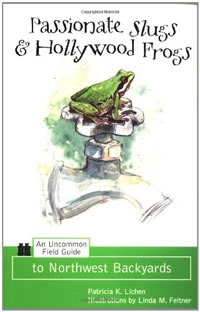 With a title like “Passionate Slugs and Hollywood Frogs,” it’s hard to know what to expect from the 2001 book by Patricia K. Lichen, but the sub-title helps: “An Uncommon Field Guide to Northwest Backyards.” This is mainly a guide to the birds and other animals–natives and non-natives alike–who may call your backyard home, plus a few plants including iconic trees, some troublesome invasives, and even your lawn and its “three million tiny plants.” The essays are short and full of whimsy, but also plenty of good information and the incentive to appreciate what you have in your own, well, backyard. The book concludes with an invitation to look up and appreciate rainbows and the stars at night–charming.
With a title like “Passionate Slugs and Hollywood Frogs,” it’s hard to know what to expect from the 2001 book by Patricia K. Lichen, but the sub-title helps: “An Uncommon Field Guide to Northwest Backyards.” This is mainly a guide to the birds and other animals–natives and non-natives alike–who may call your backyard home, plus a few plants including iconic trees, some troublesome invasives, and even your lawn and its “three million tiny plants.” The essays are short and full of whimsy, but also plenty of good information and the incentive to appreciate what you have in your own, well, backyard. The book concludes with an invitation to look up and appreciate rainbows and the stars at night–charming.
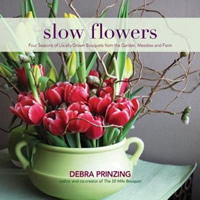 “Slow Flowers” is something of a sequel to “The 50 Mile Bouquet,” Debra Prinzing’s previous book (co-created with photographer David Perry) about local and sustainable cut flower vendors. In this book, she uses the produce (flowers, leaves, seedpods, cones, and other plant material) from those vendors, plus cuttings from her own yard and those of friends to create a calendar full of arrangements, one for each week of the year.
“Slow Flowers” is something of a sequel to “The 50 Mile Bouquet,” Debra Prinzing’s previous book (co-created with photographer David Perry) about local and sustainable cut flower vendors. In this book, she uses the produce (flowers, leaves, seedpods, cones, and other plant material) from those vendors, plus cuttings from her own yard and those of friends to create a calendar full of arrangements, one for each week of the year.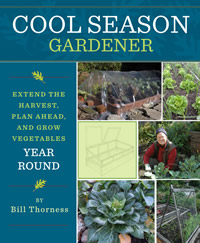
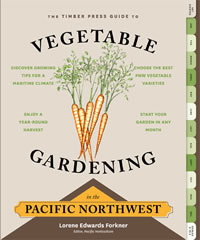 In “The Timber Press Guide to Vegetable Gardening in the Pacific Northwest,” Lorene Edwards Forkner gives a whole calendar of ideas of what to plant and what to harvest every month–what’s unusual is that the chapter on January, while having fewer pages, is still on equal footing with June, rather than be relegated to an off-season category.
In “The Timber Press Guide to Vegetable Gardening in the Pacific Northwest,” Lorene Edwards Forkner gives a whole calendar of ideas of what to plant and what to harvest every month–what’s unusual is that the chapter on January, while having fewer pages, is still on equal footing with June, rather than be relegated to an off-season category.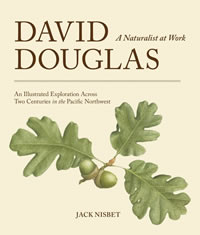 Jack Nisbet’s first book about David Douglas (“The Collector” from 2009) was a very popular, journal-like life chronology of the intrepid plant explorer. The enthusiastic response led the author to realize “…I had only begun to touch the dynamic worlds he [Douglas] saw. So I went back on the trail, revisiting places he had described, checking on species of flora and fauna he had collected, following any lead that might reveal additional facets of his career and character.”
Jack Nisbet’s first book about David Douglas (“The Collector” from 2009) was a very popular, journal-like life chronology of the intrepid plant explorer. The enthusiastic response led the author to realize “…I had only begun to touch the dynamic worlds he [Douglas] saw. So I went back on the trail, revisiting places he had described, checking on species of flora and fauna he had collected, following any lead that might reveal additional facets of his career and character.” The Orchard Mason Bee by Bellingham author Brian Griffin has long been my go-to book on this subject, but from just across the border in Coquitlam, B.C., is a slightly newer book (2002) on these fascinating garden helpers.
The Orchard Mason Bee by Bellingham author Brian Griffin has long been my go-to book on this subject, but from just across the border in Coquitlam, B.C., is a slightly newer book (2002) on these fascinating garden helpers. 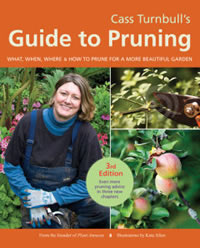 Cass Turnbull needs no introduction to our readers and a new book by her is a cause for celebration. Her “Guide to Pruning” is now available in its 3rd edition with three added chapters, including a much needed essay on Taming the Native-Plant Garden. She also addressed an impressive list of new plants not considered in the earlier editions, including “whackables” such as Lavatera and Perovskia. Oh, how I wish I had read about the dangers of whacking too soon–before making my mid-February cutbacks in my own garden.
Cass Turnbull needs no introduction to our readers and a new book by her is a cause for celebration. Her “Guide to Pruning” is now available in its 3rd edition with three added chapters, including a much needed essay on Taming the Native-Plant Garden. She also addressed an impressive list of new plants not considered in the earlier editions, including “whackables” such as Lavatera and Perovskia. Oh, how I wish I had read about the dangers of whacking too soon–before making my mid-February cutbacks in my own garden.